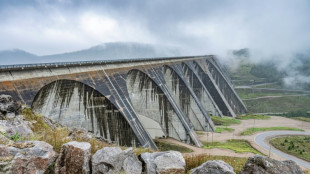
-
 Landmine victims gather to protest US decision to supply Ukraine
Landmine victims gather to protest US decision to supply Ukraine
-
Indian rival royal factions clash outside palace

-
 Equity markets retreat, dollar gains as Trump fires tariff warning
Equity markets retreat, dollar gains as Trump fires tariff warning
-
Manga adaptation 'Drops of God' nets International Emmy Award

-
 China's Huawei launches 'milestone' smartphone with homegrown OS
China's Huawei launches 'milestone' smartphone with homegrown OS
-
Philippine VP denies assassination plot against Marcos

-
 Four Pakistan security forces killed as ex-PM Khan supporters flood capital
Four Pakistan security forces killed as ex-PM Khan supporters flood capital
-
Hong Kong's legal battles over LGBTQ rights: key dates

-
 US lawmakers warn Hong Kong becoming financial crime hub
US lawmakers warn Hong Kong becoming financial crime hub
-
Compressed natural gas vehicles gain slow momentum in Nigeria

-
 As Arctic climate warms, even Santa runs short of snow
As Arctic climate warms, even Santa runs short of snow
-
Plastic pollution talks: the key sticking points

-
 Indonesia rejects Apple's $100 million investment offer
Indonesia rejects Apple's $100 million investment offer
-
Pakistan police fire tear gas, rubber bullets at ex-PM Khan supporters

-
 Ronaldo double takes Al Nassr to brink of AFC Champions League last 16
Ronaldo double takes Al Nassr to brink of AFC Champions League last 16
-
Pakistan police fire tear gas, rubber bullets at pro-Khan supporters

-
 Hong Kong same-sex couples win housing, inheritance rights
Hong Kong same-sex couples win housing, inheritance rights
-
Indonesia digs out as flooding, landslide death toll hits 20

-
 Liverpool's old guard thriving despite uncertain futures
Liverpool's old guard thriving despite uncertain futures
-
Mbappe takes reins for Real Madrid in Liverpool clash

-
 As AI gets real, slow and steady wins the race
As AI gets real, slow and steady wins the race
-
China's Huawei to launch 'milestone' smartphone with homegrown OS

-
 Porzingis and Morant make triumphant NBA returns
Porzingis and Morant make triumphant NBA returns
-
Hong Kong top court affirms housing, inheritance rights for same-sex couples

-
 Philippines, China clashes trigger money-making disinformation
Philippines, China clashes trigger money-making disinformation
-
Most Asian markets drop, dollar gains as Trump fires tariff warning

-
 England 'not quivering' ahead of New Zealand Test challenge
England 'not quivering' ahead of New Zealand Test challenge
-
Bethell to bat at three on England Test debut against New Zealand

-
 Trump vows big tariffs on Mexico, Canada and China
Trump vows big tariffs on Mexico, Canada and China
-
New Zealand and England to play for Crowe-Thorpe Trophy

-
 Scheffler, Schauffele and McIlroy up for PGA Player of the Year
Scheffler, Schauffele and McIlroy up for PGA Player of the Year
-
Trump to face less internal pushback in new term: ex-commerce chief

-
 Extreme weather threatens Canada's hydropower future
Extreme weather threatens Canada's hydropower future
-
More than 34,000 register as candidates for Mexico judges' election

-
 Australia ban cycling's Richardson for life after UK defection
Australia ban cycling's Richardson for life after UK defection
-
Internal displacement in Africa triples in 15 years: monitor

-
 'Remarkable global progress': HIV cases and deaths declining
'Remarkable global progress': HIV cases and deaths declining
-
Social media firms raise 'serious concerns' over Australian U-16 ban

-
 Tiger to skip Hero World Challenge after back surgery
Tiger to skip Hero World Challenge after back surgery
-
MLB shifts six 2025 Rays games to avoid weather issues

-
 US women's keeper Naeher retiring after Europe matches
US women's keeper Naeher retiring after Europe matches
-
Dow ends at fresh record as oil prices pull back on ceasefire hopes

-
 West Ham stun Newcastle to ease pressure on Lopetegui
West Ham stun Newcastle to ease pressure on Lopetegui
-
Menendez brothers' bid for freedom delayed until January

-
 Arteta calls on Arsenal to show 'ruthless' streak on Champions League travels
Arteta calls on Arsenal to show 'ruthless' streak on Champions League travels
-
Israel bids emotional farewell to rabbi killed in UAE

-
 Sonar image was rock formation, not Amelia Earhart plane: explorer
Sonar image was rock formation, not Amelia Earhart plane: explorer
-
Tottenham goalkeeper Vicario has ankle surgery

-
 Prosecutor moves to drop federal cases against Trump
Prosecutor moves to drop federal cases against Trump
-
Green light for Cadillac to join Formula One grid in 2026


Iran fights to recover stolen antiquities
Decorated glazed bricks almost 3,000 years old are on display at Iran's National Museum after a four-decade search disrupted by war and an international legal battle.
Lions and winged cows with human heads, horses and bulls with a goat's horn, kneeling men and women and other mythological figures decorate the work, created by the Mannaeans who lived in northwestern Iran in the first millennium BC.
The 51 square bricks are painted with a glazed coating on a black, brown, light blue, yellow or white background.
Their discovery and repatriation "is a series of incredible adventures," Youssef Hassanzadeh, an archaeologist with the museum, told AFP.
It is also the latest example of Middle Eastern and African countries recovering stolen antiquities which have ended up in Western countries.
According to Hassanzadeh, the story began after the 1979 Islamic revolution when a farmer, Mirza Ali, discovered painted ceramic bricks while cultivating his field. They had been used to decorate a temple near his village in West Azerbaijan province.
"People were looting and selling glazed bricks, taking advantage of the absence of government control," said Hassanzadeh, who organised the exhibition at the museum, where visitors peer at the bricks through glass cabinets.
- 'A unique collection'
A few years later in 1985, during war with Iraq, Iranian authorities sent a group of archaeologists, protected by soldiers, to the village. They started to dig and seized some bricks but it was too late for the others.
Smugglers had already shipped some of them overseas, where a number entered private collections and museums, the archaeologist said.
The story took a new turn when the British Museum learned that an Iranian family had offered to sell a set of glazed bricks in Chiasso, on the Italian-Swiss border. In 1991, the museum sent its curator John Curtis to purchase the collection.
But Curtis realised the bricks came from the West Azerbaijan site "and advised the British Museum and other European museums not to buy it, because it is a unique collection which must not be divided and must be returned to its country of origin," Hassanzadeh said.
The Iranian owner of the collection had a different view. He was not prepared to return the artifacts from Switzerland.
"In 2008, the Swiss police seized the objects. The case went to court. French archaeologist Remy Boucharlat, who led excavations in Iran, confirmed the collection's "identity", the Tehran-based museum said in a statement.
Legal proceedings dragged on for more than a decade, with a lawsuit filed by the National Museum in 2015, and pressure from Iranian diplomats.
"Finally on December 20, 2020, the collection returned to us," said Jebrael Nokandeh, curator of the National Museum which is exhibiting the bricks until Tuesday.
A separate drawn-out legal saga concluded in October, 2019 when the National Museum opened an exhibition of around 300 cuneiform clay tablets returned from the United States.
Other artifacts have also come back, but with far fewer complications.
Nokandeh, who is also an archaeologist, said a descendant of a Frenchman who lived in Iran during World War II approached Iran's cultural adviser in Paris last year to say "that he had a collection of Iranian antiquities."
Those 29 pieces, from the Bronze Age to the Islamic period, are now also on display at the museum, while the quest to recover other stolen and lost artifacts from the country's rich history continues.
"We are in talks with the United States as well as with Australia to return objects," Nokandeh said.
B.Shevchenko--BTB
